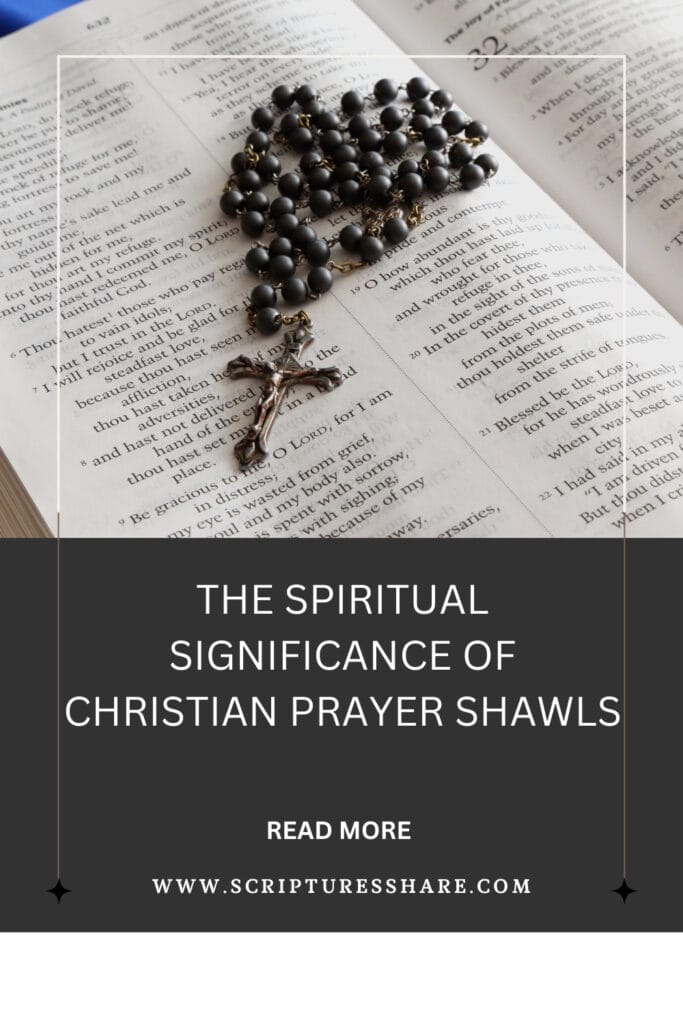No products in the cart.
The Spiritual Significance of Christian Prayer Shawls
This post contains paid and/or affiliate links. I make a small commission at no extra cost to you. Please see our Privacy Policy.
Christian prayer shawls carry deep spiritual significance and can enrich prayer life. They are not a must for Christians but have a rich history in Jewish tradition.
Originally, Jewish men wore them as a sign of obeying God’s law. They reminded them of His commandments. These shawls, or tallits, have been treasured for centuries.
A prayer shawl is a square cloth with tassels at the corners, symbolizing the 613 commandments. It represents one’s prayers and God’s presence. Wearing it can focus the mind, bring peace, and deepen connection with God.
Deuteronomy 22:12 (NIV)
“Make tassels on the four corners of the cloak you wear.”
While Christians don’t need to wear them, some do as a faith expression or to honor Jewish roots. The choice to wear a prayer shawl is personal, with varying meanings for each person.
Let’s explore the spiritual significance, history, and symbolism of Christian prayer shawls. We’ll see how they impact one’s spiritual journey.
What Is a Prayer Shawl?
A prayer shawl, or tallit in Jewish tradition, is a sacred garment for Jewish men. It shows their connection to God and commitment to His commandments. It’s a square cloth with tassels at the corners, representing the 613 commandments in the Torah.
Jewish women also wear them during prayer to show devotion and spirituality. Some Christians wear them too, recognizing their importance and Jewish roots.

Origin and History of Prayer Shawls
Prayer shawls have a rich history, dating back to biblical times. They were first used by Jewish men. These shawls were inspired by Bedouin garments, offering sun protection and faith symbols.
The design of prayer shawls has changed over time but remains deeply spiritual. Traditionally, they were made from silk and wool, symbolizing their sacred nature. The tassels and knots represent the 613 commandments in the Torah.
Through generations, prayer shawls have been treasured as a faith and heritage link. Their designs and patterns show creativity and devotion.
Psalm 91:4 (NIV)
“He will cover you with his feathers, and under his wings you will find refuge; his faithfulness will be your shield and rampart.”
The Evolution of Tallit Design
- In ancient times, prayer shawls were simple and practical, providing practicality and protection in the harsh desert environment.
- Prayer shawls became more ornate as time passed, featuring intricate patterns and vibrant colors, reflecting different regions’ artistic styles and cultural influences.
- Many tallit designs are available in modern times, ranging from traditional to contemporary. Some feature embroidered motifs, while others incorporate modern materials and techniques.
The prayer shawl remains a powerful faith symbol, worn by Jewish men and women during prayer and special occasions. While Christians don’t need to wear them, many value their history and spiritual meaning. They may include them in their prayer rituals.
Where Are Prayer Shawls Mentioned in the Bible?
Prayer shawls aren’t directly mentioned in the Bible. Yet, their roots are found in the Torah.
In Numbers 15:38-41, God tells the Israelites to make tassels on their clothes. This is to remember His commandments.
Deuteronomy 22:12 also talks about the importance of tassels. They remind us of God’s commandments.
The Significance of Prayer Shawls in Worship
Prayer shawls hold a special place in worship. They symbolize our spiritual bond with God. When we wear them, we remember God’s presence and His rule over us.
Wearing a prayer shawl can change our mindset. It helps us focus and find peace in our prayers. It creates a sacred space for deeper communion with God.
Prayer shawls also represent our shared faith. They show the unity and collective prayers of the community.
Spiritual Symbolism
Prayer shawls carry deep spiritual symbolism. The fabric shows our openness to God’s love and protection. The fringes remind us of God’s commandments and our commitment to His Word.
The four corners with fringes symbolize the 613 commandments in the Torah. Holding onto these fringes connects us to the wisdom of the sacred text.
Colossians 3:17 (NIV)
“And whatever you do, whether in word or deed, do it all in the name of the Lord Jesus, giving thanks to God the Father through him.”
Prayer Shawls in Worship
Using prayer shawls in worship enriches our experience. They help us focus on our devotion, away from distractions. Prayer shawls remind us of our spiritual bond with God and our unity.
Prayer shawls are a beautiful way to show our faith. They are not required in Christian worship but are valuable for many. Through them, we deepen our faith, find comfort in God’s presence, and seek His guidance.
Why Do Christians Not Wear These Today?
Christian prayer shawls, or Dalits, are not mandatory for Christians. With Jesus’ arrival and the new covenant, Christians are free from the Old Testament’s laws and rituals. They focus on God’s grace and the freedom in Christ.
Yet, some Christians wear prayer shawls to express their faith or honor Jewish traditions. It’s a way to connect with the rich history and symbolism of prayer shawls. It reminds them of their devotion and aids in deepening their prayer life.
While not common among all Christians, wearing a prayer shawl is a personal choice. It depends on one’s beliefs and desire to incorporate prayer shawls into their worship and prayer.
Conclusion
Prayer shawls hold deep meaning in both Jewish and Christian traditions. They are not required by the Christian faith but can greatly enhance prayer life. They help deepen the connection with God.
The spiritual significance of prayer shawls is profound. They represent prayers physically, reminding us of God’s presence. They symbolize His authority and power. Wearing a prayer shawl during prayer can bring focus, peace, and a stronger spiritual connection.
Choosing to wear a prayer shawl is a personal decision. Its significance can vary among individuals. Some Christians honor Jewish roots or express their faith. Others might find it challenging. What’s key is the heartfelt intention and sincere desire to connect with God.
FAQ
What is the significance of Christian prayer shawls?
Christian prayer shawls hold deep meaning and can enhance one’s prayer life. While not a requirement for Christians, prayer shawls are a physical representation of one’s prayers, a reminder of God’s presence, and a symbol of His authority and power.
What is a prayer shawl?
A prayer shawl, also known as a tallit, is a unique garment worn by Jewish men and sometimes women to signify their connection to God and the observance of His commandments. It is a rectangular cloth with tassels at the four corners, symbolizing the 613 commandments in the Torah.
What is the origin and history of prayer shawls?
Prayer shawls have a long history that dates back to biblical times. They were initially worn by Jewish men, inspired by the outer garments worn by Bedouins to protect them from the desert sun. Made from a mixture of silk and wool, prayer shawls have evolved in design and are still used today to connect with God.
Where are prayer shawls mentioned in the Bible?
While prayer shawls are not explicitly mentioned in the Bible, their origins can be traced to scriptural references in the Torah. In Numbers 15:38-41 and Deuteronomy 22:12, God instructs the Israelites to make tassels on the corners of their garments as a reminder of His commandments.
What is the significance of prayer shawls in worship?
Prayer shawls hold spiritual significance in worship. They are a physical representation of one’s prayers, a reminder of God’s presence, and a symbol of His authority and power. Wearing a prayer shawl during prayer can help focus one’s mind, bring peace and calm, and create a deeper connection with God.
Why do Christians not wear these today?
Christians are not required to wear prayer shawls. With the coming of Jesus and establishing a new covenant, believers are no longer bound by the Old Testament laws and rituals. While some Christians may choose to wear prayer shawls as a personal expression of their faith or to honor the Jewish roots of Christianity, it is not a universal practice.
What is the spiritual significance of prayer shawls?
With their rich history and spiritual symbolism, prayer shawls have played a significant role in Jewish tradition and continue to hold a special place in the hearts of Christians. While not mandated by the Christian faith, prayer shawls can be a powerful tool for enhancing one’s prayer life and deepening their connection with God. The decision to wear a prayer shawl is personal, and its significance varies from individual to individual.











